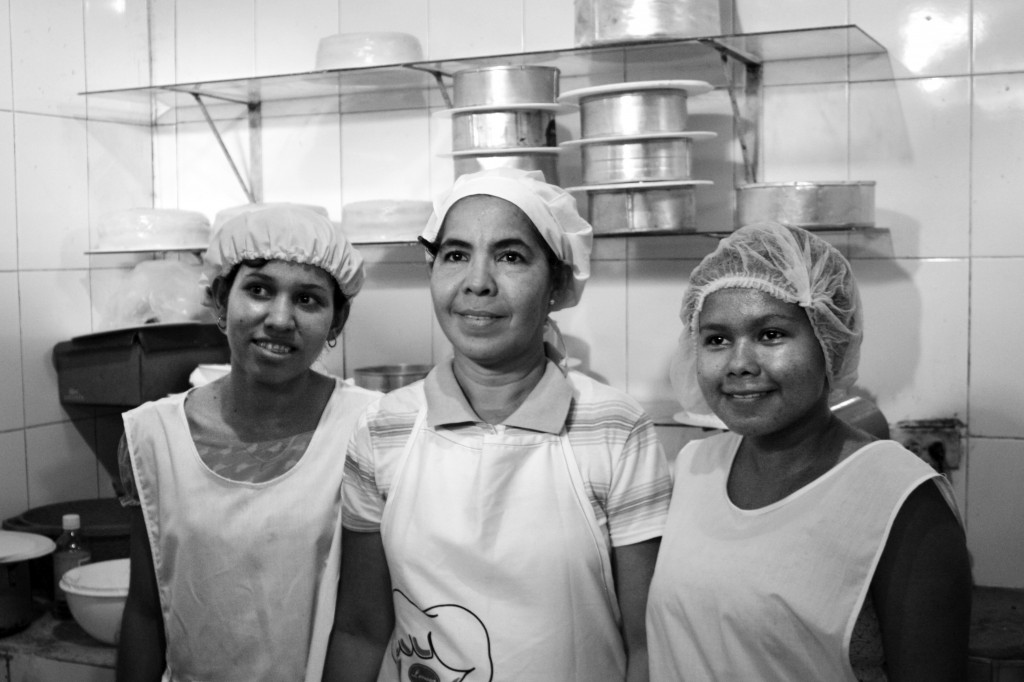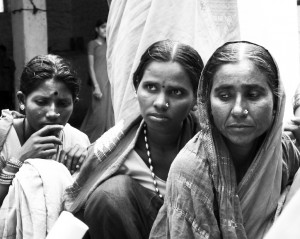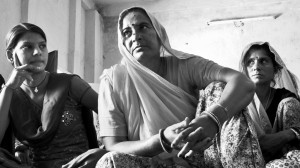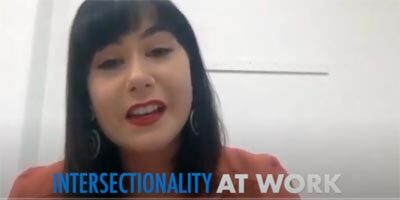
“As she took out larger loans and built up her savings, Melvis was able to purchase some equipment and hire two additional staff. She now sells thirty cakes a week, and has her own street side shop.” Photo courtesy Opportunity International
Brady Josephson, national director of Opportunity International Canada, a charity providing financial services to the poor in developing countries, is eager to talk about how microfinance can succeed.
“Melvis is an unbelievable baker, amazing, who was selling, on average, eight cakes a week before she joined Opportunity. She had a great talent, but spent so much time collecting ingredients, baking without proper tools and having to do the entire cake herself she was unable to grow her business.
“With an initial loan of just $180 she was able to purchase the raw materials in bulk cutting down on time and costs therefore increasing her profits. Melvis needed a small injection of capital to create jobs for her neighbours and generate profits to build her business and provide for her family.”
There are many success stories in microfinance where clients thrived on businesses started on small loans.
But there are also stories of how microfinance has failed its clients. With interest-rates between 30% and 70% in India, many borrowers have debts they cannot repay. They often resort to taking out more loans to repay original loans, and get even deeper into debt. Depression and suicide can be the result.
A new study of microfinance, “What is the impact of microfinance on poor people? A systematic review of evidence from sub-Saharan Africa,” recently published by the Social Science Research Unit (SSRU) at the University of London, concludes that “Some people are made poorer, and not richer, by microfinance, particularly micro-credit clients.”
The Society for Elimination of Rural Poverty, a government agency, counted 70 microfinance-related suicides in Andhra Pradesh from March to mid-November 2010.
The importance of microfinance
The UN Capital Development Fund (UNCDF) works with investments in the world’s 48 least developed countries. It defines microfinance as a form of inclusive finance, providing “large-scale access to a variety of financial services for poor and low-income people and micro and small enterprises.”
Hanadi Tutunji, a programme specialist at UNCDF, described the importance with which the agency views microfinance. “Inclusive financial systems are critical infrastructure, just like roads. For over two billion people in the world who live on less than $2 per day, access to financial products and services can directly provide the tools to protect, diversify, and increase their sources of income and to make their own economic decisions for the path out of poverty. The level of outreach by the financial sector also correlates strongly with the level of financial, institutional and infrastructure development across countries.”
Microfinance is not limited to loans, but is actually a collection of financial tools for the poor that includes micro-savings. Microfinance credit provides the poor with small loans, usually used for entrepreneurship, which need to be repaid on a regular basis, while micro-savings works like a regular savings service for small deposits to provide a place to store funds. Current research shows different levels of success for micro-credit and micro-savings.
“The negative reports of micro-credit have focused primarily on the rapid growth of credit in some markets, such as certain regions of India, leading to over indebtedness among some clients,” Tutunji said. “The provision of savings services to clients continues to receive more positive assessment. But microfinance can be harmful when loans are given to very poor people who don’t have any income. In this case, other poverty reduction mechanisms can be better suited to help them.”

“As she took out larger loans and built up her savings, Melvis was able to purchase some equipment and hire two additional staff. She now sells thirty cakes a week, and has her own street side shop.” Photo courtesy Opportunity International.
Setting the right goal
The SSRU report suggests that a key point in minimizing cases where microfinance does more harm than good is to focus on short-term instead of long-term goals and limit financial services provision to suitable clients only. Regular repayments mean that using microfinance to achieve certain long-term goals can cause unwise investments which lead to indebtedness.
“For microfinance to benefit clients, they actually have to make a profit as a result of the loan or savings account, and often very quickly with repayments due on a weekly or monthly basis,” Stewart said. “It is not realistic to expect clients to invest in longer term outcomes such as their children’s education. Doing so is likely to mean that they will be poorer in the short to medium term and not richer. So associating long-term goals and microfinance seems to have one of two outcomes – the goal is actually ‘damaged’ because clients have to divert their money towards paying off loans, or the clients pursue the ‘goal’ but find themselves over-indebted as they cannot pay their loans or fees quickly enough.”
The need to limit access
The need for quick returns means that only those able to immediately generate profits may benefit from microfinance loans. Microfinance institutions (MFIs) therefore need to discriminate in choosing their clients instead of aiming for maximal outreach. “The emphasis on reaching the ‘poorest of the poor’ may be flawed. There may be a need to focus more specifically on providing loans to entrepreneurs, rather than treating everyone as a potential entrepreneur,” the SSRU report argues.
Ms. Tutunji agreed that the services provided must be matched to specific types of clients.
“In terms of credit, it is very important that microfinance programmes define clearly their target population, develop suitable products to serve them, and seek sustainability of the services and programmes so that the services to the people are not terminated or cut when programmes end.”
Responsible implementation of microfinance may mean limiting the poor’s access to services, Stewart says. “If microfinance is meant to be a market-led financial service, it should be used responsibly. That may mean that those people who are very poor and have very little chance of making the profit required to repay should not be offered access. If you consider that micro-debt is the other side of the same coin, then you can easily see that helping the poorest and most vulnerable avoid debt is a good thing and not a limitation.”
Tutunji says that the UNCDF supports setting standards for financial service providers through performance-based agreements, with clear performance targets related to outreach and efficiency, quarterly reporting, and audited financial statements.
Client selection and protection
Minimizing harm means successfully screening out unsuitable clients, Stewart says. “Unless the clients are able to make enough money to pay the interest rates charged on fees, or the fees associated with savings, then microfinance is likely to fail to help them – it’s very logical. MFIs therefore have to work to identify those clients that they are most likely to help. More work is needed in this area in order to maximize benefits and minimize harms.”
Josephson says that Opportunity International agrees with taking a careful approach. “We don’t give loans to just anyone, nor should we. Not everyone can start and manage their own business. We only give loans to entrepreneurs that we believe possess the skill set and business plan to be successful.”
Client protection does not stop at ensuring suitability.
“The microfinance industry is putting measures in place to better protect clients,” Tutunji said. “For example, the UNCDF is an endorser and a steering committee member of the Smart Campaign for client protection. We request that all financial services providers we partner with endorse this campaign and sign to work on the principles for client protection.”
Josephson says that they give each client no more than two loans at a time to avoid over-indebtedness. “The main measure Opportunity uses is training. We are committed to equipping our clients with the tools they need to be successful and I don’t just mean financial products. Even before a client receives a loan in Colombia for example, she will have had 6-8 weeks of training on issues of cash flow, management and marketing strategies. We provide education on financial literacy and planning, and the importance of expense control and education for their children.”

The President of the Lakshminidi Women’s MicroFinance Cooperative Society in Niwai, Rajasthan, with leading members of the society. Photo: Austin Yoder.
Microfinance for development, or for profit
MFIs are not all development-driven. The high repayment rates in microfinance have attracted organizations that see it as a financial opportunity, and don’t take on the expenses involved in social commitment.
“Many for-profit institutions will charge as high a rate as they can get away with and keep their ratings and portfolios intact,” Josephson said.
Stewart says that clients should be given support, rather than be targeted by financial service providers seeking to make a profit from them.
“Microfinance is a financial intervention, not the social and development intervention it has come to be lauded as,” she said. “If the world’s poorest people need help in setting up sustainable sources of income to enable them to lift themselves out of poverty, then what is needed is not a loan at a high interest rate. Making money from the poor is very different from helping them to make money.”






